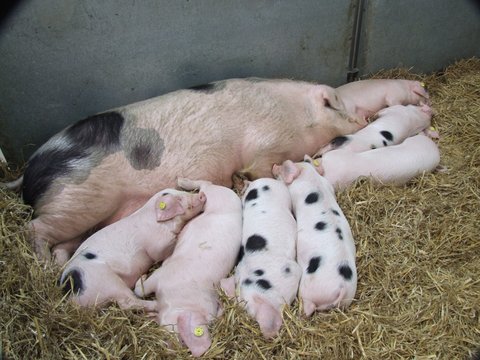By Gwawr Hughes, Farming Connect Pigs and Poultry Technical Officer
With pig prices in some instances below the cost of production, pig farmers are being urged to maximise outputs to make up for losses elsewhere. One area of production which could be targeted for improvements is piglet survival. Pre-weaning mortality rates currently average between 16-20% in the UK. This is a potential loss of £22 million in net profit annually which is a significant economic loss to the UK pig industry (SRUC, 2016).

The ‘light pig syndrome’ issue has been a concern at the forefront of the British pig industry for a number of years. Many producers question the feasibility of keeping these pigs on as they’re often deemed unprofitable and inefficient. Research has shown that improving post-weaning nutrition is ineffective and that a ‘prevention is better than cure’ attitude should be adopted from the offset. Reducing the probability of light pigs or runts in litters as they’re known, needs to start before they’re born, and this is where pre-farrowing nutrition and management is critical.
Studies have shown that an increase of 1.3 piglets weaned per litter, which is the difference between the average herd and herds in the top 10% of performance, improves net margin by £60 per sow annually (BPEX, 2009).
In retrospective, the difference between 12% and 6% of piglets born alive is 0.6 piglet surviving in a litter of ten and near one whole piglet more in a litter of 16. If these piglets were to survive (with the allowance of some deaths later towards finishing weight), this equates to selling 2.2 more finished pigs per sow per year for the big litters of the future. This converts to approximately 170kg more of saleable meat per sow. This is for the exact same cost of production as the sow still has to be housed, fed and managed regardless of whether or not all her piglets survive until weaning.
Promoting good management and nutrition during the pre-farrowing period can significantly impact the vitality and vigour of newborn piglets. Feeding a high quality diet at regular intervals and including a supplementary feed will contribute towards vigorous piglets at birth. Supplementing regular feeding with dextrose could provide an additional energy source during gestation. Sows must be monitored carefully during this period for any signs of ill-health which may impact on piglet vitality.
After farrowing, it is crucial that piglets receive the best care possible during the first hours of life and therefore after. It has been proven that the time spent with newborn piglets plays a critical part in pre-weaning mortality rates. Pig units that spend as little as 8% of their daily labour availability with newborn piglets found that pre-weaning mortality was 12% or above. Those pig units who spend at least 16% of their daily labour availability had their pre-weaning mortality rates down to 7% or less. A pre-weaning mortality rate of 12% equates to 170kg of meat lost at approximately 117p/kg (February 2016), which is a loss of £198.90.
As well as keeping a closer eye on newborn piglets, producers should consider the benefits of introducing creep feed as young as three days of age, and persist feeding through until weaning. Supplementing sows’ milk with creep feed can result in increased weight gains pre-weaning as well as improve post-weaning performance. The improvement in post-weaning performance as a result of creep feeding at a young age can lead to increased net returns of up to £2 per pig (BPEX, 2013).
Ensuring that farm staff are focused on prioritising piglet survival is essential in all pig units in order to keep rates down. Attention to detail is highly important when handling newborn piglets. The same attention to detail should be adopted throughout their lifetime, especially until the weaning period. Introducing an on-farm protocol which focuses on prioritising piglet welfare could be a positive step forward for pig producers and lead to higher gains as well as a more sustainable, efficient industry.
